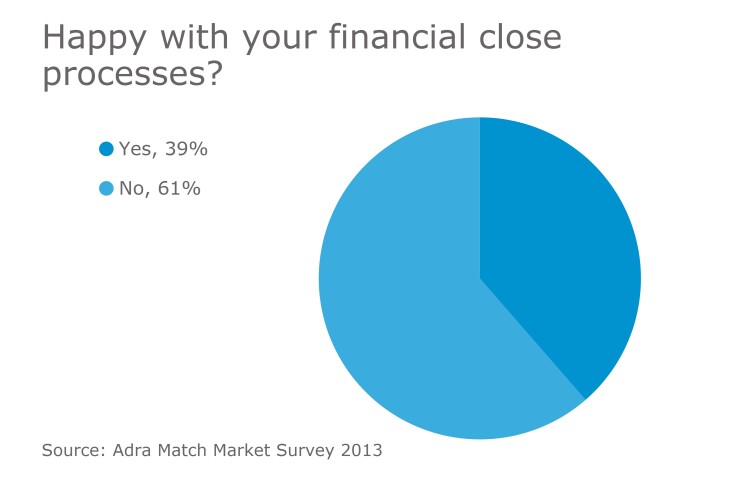Old habits, including business processes, die hard — and for many organizations, the monthly close is the perfect example. While other accounting functions have applied technology to streamline and automate recurring tasks, the monthly close process has remained mired in inefficiencies.

Consider what many accountants undergo repeatedly, even in today’s world of sophisticated software: The current “close reality” includes labor-intensive activities that still rely on disparate checklists, decentralized departmental communications, long email chains, endless status meetings and tedious reconciliation processes. These all add up to hours and days of time which could be better spent on value added activities.
And each of the stakeholders involved — the CFO, controller, accountants and staff — has a vested interest in improving the close process, whether for regular monthly activities, a pending audit or the simple predictability of getting out of the office on time for family activities.
Today, in a future-thinking technology climate where few activities fall under the radar of business process improvement, close management software solutions are an emerging reality that can be leveraged in a simple to implement, fast and cost effective manner. In essence, these solutions enable accounting departments to close the books in an automated fashion, one that helps to reduce time to close, mitigate errors and make financial reporting more accurate and efficient. They integrate with a variety of essential ERP systems and are typically easy to use for all levels of accounting personnel, from staff accountants to the executive suite. Some offer a centralized dashboard that articulates the activities, specific responsibilities and progress for each contributor, to ensure ongoing and accurate close results, month over month.
The benefits of close management software are various, but they all tie back to the ability to centralize and automate the time-gobbling activities that characterize yesterday’s manual, non-standardized approach to closing.
Some areas of concern where close management software solutions can assist are as follows:
1. Reconciliation has often been a monotonous, manual process requiring extensive formatting of inconsistent information. Automation can offer huge time savings by aligning data from various sources (General Ledger, Excel and other systems) and providing the ability to easily identify and reconcile them. Some close management systems offer added functionality including intelligent transaction matching for even greater reconciliation automation.
2. Accuracy of month-end and year-end results have sometimes been problematic, given the sheer magnitude of the close tasks, limited time to complete and fragmented nature of the processes used to reach a final result. Close management software can be put in place to both codify and streamline the breadth of close tasks into repeatable functions. This allows the time to complete them more systematically, through the elimination of manual chores. It can also greatly mitigate the opportunity for human error. The net outcome of the solution becomes accurate, defensible close results with more time for qualitative analysis, and confident readiness for executive review.
3. Communication between a variety of ERP systems and Excel, where many accountants spend the bulk of their time, has been marginal at best. Close management can provide the functional bridge needed between disparate ERP applications and Excel-resident data for financial reporting. And while cloud-based applications dominate some application areas, financial information must remain secure and often is not a candidate for the cloud. Here, communication between close management and third party content management systems can deliver the conduit needed for both information flow and security.
4. Centralization of the variety of close activities has often been lacking in manual approaches. Previously, a litany of checklists, email communications, in-person meetings and ad-hoc conversations were the only means available to reach month-end. Close management software helps coalesce many close activities, typically into a single dashboard, where criticality of tasks and percentage of completion are clearly articulated. Alerts and reviews are automatically generated, and daily activities are outlined. This information can be shared group-wide on a real time basis, eliminating many error-prone, isolated activities. Supporting documents can also be saved with their associated accounting process, preventing time-consuming file searches.
5. Collaboration between accounting management and staff also pose challenges for organizations, especially for those that are growing quickly, and have a need to improve workflow and engage in continuous process improvement. Close management software can provide the tools necessary to keep accounting staff members of all levels on the same page regarding their role in the close process, and highlight any key dependencies for which they may be responsible. This knowledge not only assists the controller with close progress status, but includes everyone on staff in the implementation of ongoing process enhancements, while creating a greater sense of ownership of their assigned tasks. Some close management solutions also provide a straightforward way for senior staff to contextually share advice and experience with more junior staff members.
6. Compliance and audit simplicity are often a difficult reality. Having predictable, ready-to-roll transaction information for SOX compliance, preparing for an IPO and/or year-end audits can stress even the most organized team, and occupy huge amounts of time. Close management software can assist in several critical ways, from organizing and helping provide the required audit documents, to facilitating any walkthrough of historical data. The processes that close management will have helped create and enforce will become the baseline for validating necessary internal controls, and remove some of the retroactive work otherwise required to comply.
Close management software is a time- and anxiety-saving solution that takes the “art of the close” to new levels by centralizing outdated, manual accounting tasks and replacing them with ones that are organized, automated, transparent, inclusive of all constituents, and when selected thoughtfully, functionally complete and simple to implement and use.





